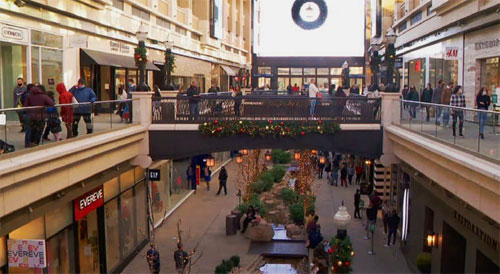By Brice Wallace
While holiday spending may slip a bit this season, it remains “a critical time” for many small businesses.
That’s the forecast by Robert Spendlove, economist at Zions Bank, who used a pre-Thanksgiving news conference to cite research by the National Retail Federation showing shoppers expect to spend an average of about $1,000 on gifts, food, decorations and other holiday-related purchases this holiday season. That’s about $50 less than last year’s average.
In response to the COVID-19 pandemic, many retailers are discouraging crowds by spreading out sales and promotions over several weeks, he noted.
“Despite the pandemic, consumers still have a healthy appetite for holiday spending, although what we’ve noticed is, this appetite has been impacted and tempered slightly by economic uncertainty,” Spendlove said.
While Utah’s economy is faring relatively well, the economy recovery has been uneven, with some economic sectors doing well while others continue to struggle.
“For instance, while the construction and manufacturing sectors are doing really well right now, other sectors such as mining and also leisure and hospitality continue to suffer due to much lower consumer demand,” he said.
“This year’s holiday spending season could help some businesses recover as people buy more gifts, food and decorations. Holiday sales in November and December usually account for about 20 percent of U.S. annual retail sales, and for some retailers, that figure is even higher. So this is a critical time for many of those retailers to make their revenues and make profits for the entire year.”
As for individual items, 54 percent of holiday shoppers are expected to have clothing on their lists, followed by gift cards (49 percent), toys (37 percent) and books and other media (35 percent). More people than ever before — 60 percent — plan to making holiday purchases online, and 96 percent of retailers expect their online holiday sales to grow.
In what Spendlove called “an encouraging sea change” during the pandemic, consumers are showing increased interest in shopping at small businesses.
“About 77 percent of shoppers say they are choosing to shop local this year, while 75 percent plan to be more conscious about where they shop during this holiday season,” he said. “Consumers also say they care about shopping at establishments owned by minorities and women, which is very encouraging.”
A study from Mastercard SpendingPulse showed that about 75 percent of consumers say they plan to shop at businesses whose values line up with their own.
The news conference took place at A La Mode SLC, owned by two black women, Jasmine and Angelique Gordon. They’re part of approximately 3 percent of U.S. business owners who are black women.
“And that number has contracted since the pandemic,” said James Jackson III, founder and director of the Utah Black Chamber and who oversees supplier diversity at Zions Bank. “Overall, black-owned businesses have been hit very hard during this pandemic, and many of them are not going to come back, unfortunately, closing twice the rate of other small businesses.”
That environment has prompted the social media campaign “Buy Black Friday,” launched by Facebook and the U.S. Black Chamber of Commerce and encouraging shoppers to make purchases at black-owned businesses not just on Black Friday but throughout the holiday season.
“Buy Black Friday should be just the beginning of our support for diverse businesses to strengthen our culture and our landscape and our overall economy,” Jackson said, “because as small businesses flourish, so do their communities.”
Nationally, the National Retail Federation (NRF) is expecting overall holiday sales to rise somewhere between 3.6 percent and 5.2 percent over last year’s figure. That would put the sales total for the period between $755.3 billion and $766.7 billion. In that total are online sales, expected to grow 20 percent to 30 percent and reach between $202.5 billion and $218.4 billion. Adobe Analytics has predicted online sales in November and December to grow to $189 billion, up 33 percent from last year.
“Given the pandemic, there is uncertainty about consumers’ willingness to spend, but with the economy improving, most have the ability to spend,” said Jack Kleinherz, the NRF’s chief economist. “Consumers have experienced a difficult year but will likely spend more than anyone would have expected just a few months ago.”








